
In my Viking dreams, in a Viking room on Viking lands, I hear whispers of Ragnarök. Or maybe it was Ragnarøkkr? It could have been either, considering I cannot really comprehend Old Norse and who drags their dreams out of that world intact anyway. This distinction is important as the former expression is about the end of an age, while the latter refers to the twilight of the gods. I also carry vague memories of Idun trying to introduce me to another god, some deity of raspberries. While Idun was the Goddess of Youth who protected the Apples of Immortality, I think this other god was protecting the Raspberries of Delight, and since we found them growing wild next to the Nærøyfjord, we would continue to travel in delight.
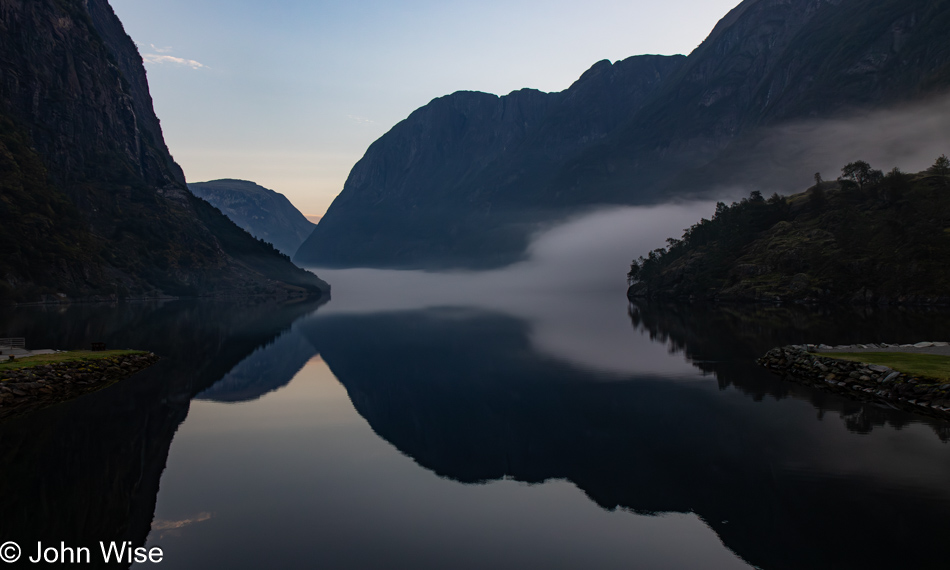
The whisps of foggy mist hug the surface of the fjord while filament-like strands stretch and disappear over the trees. A scene one should be so fortunate to see with their own eyes at least twice in their life. Between Denmark, Sweden, and Norway, it is likely this last Scandinavian country that holds the biggest draw, pulling us back for a return visit, or so I want to think while still in Norway. The grandeur of the fjords cannot adequately be depicted by any form of media as the full senses are required to linger in the expanse and massive nature of it all.
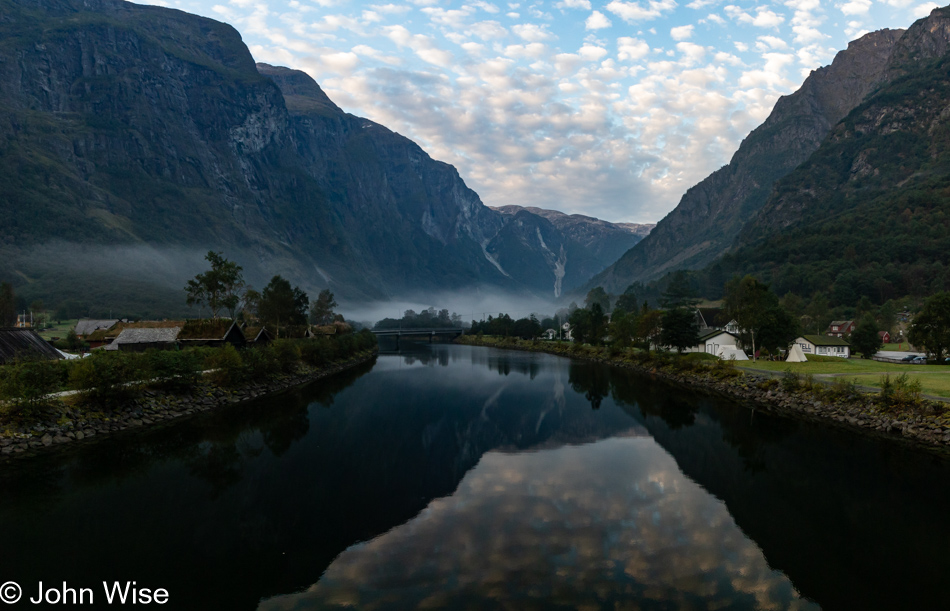
A couple of days ago, I shared the story of an Australian couple pressing into their 80s on a five-week cruise from New York City to Greenland, Iceland, and Svalbard. Well, it got me thinking about where I am. As we go walking along, here I am at 60 years old, hoofing about 10 miles (16 kilometers) or more a day while we are on vacation, and on occasion, we are not averse to riding bikes between 13 and 20 miles to explore other perspectives of seeing our amazing world. Typically, we are up and going between 6:00 and 7:00 a.m. and don’t quit much before 10:30 p.m.. Our stamina is still quite adequate in our view, though, at times, we are not beyond passing out at 9:00 p.m. Compared to my father, who lost his limbs to diabetes in his forties, or my mother, who could no longer push herself to do much of anything after she turned 50, I can appreciate that Caroline and I are trying to wring every bit of adventure out of our lives. On the other hand, Caroline’s parents have done well into their 80s and nearly 90s, aside from her mom’s dementia.
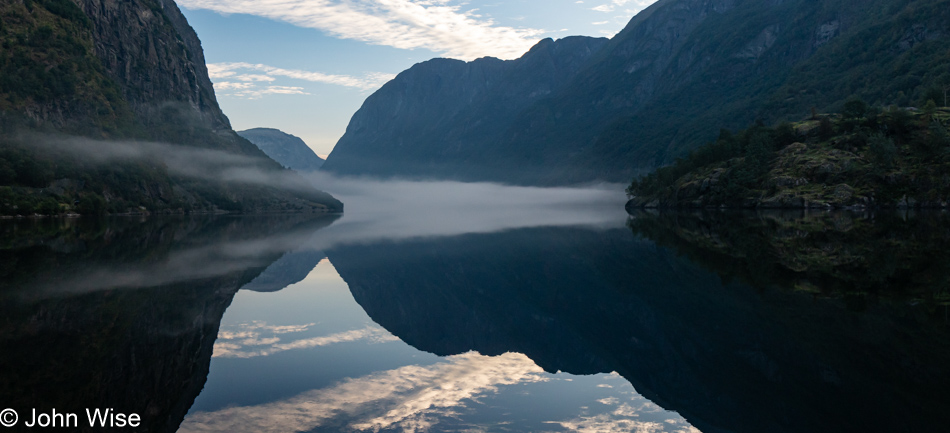
I’m keenly aware of our own countdown and want to take full advantage of bodies that remain performant. That old idiom about hindsight and its 20/20 nature has me wanting to tell 20-year-old John to forego everything he thought were absolute necessities, such as nice restaurants, cars, bigger living spaces, and other perceived convenient comforts, and only invest in experiences because, in the end, they hold far more meaning than any car, meal, house, furniture, clothes, or other expressions of who I thought I was demonstrating.
But how would I ever negotiate with a horny young man struggling to find who he was and what he meant to others? Speaking to my still-immature self when I couldn’t comprehend that post-puberty, I traded my passion for learning against the desire for carnal pleasures. I became a slave to vanity. All the while, the engine of commerce, a.k.a. marketing, helped this young man lose focus of who he was while grooming me to want to be the person others would desire.
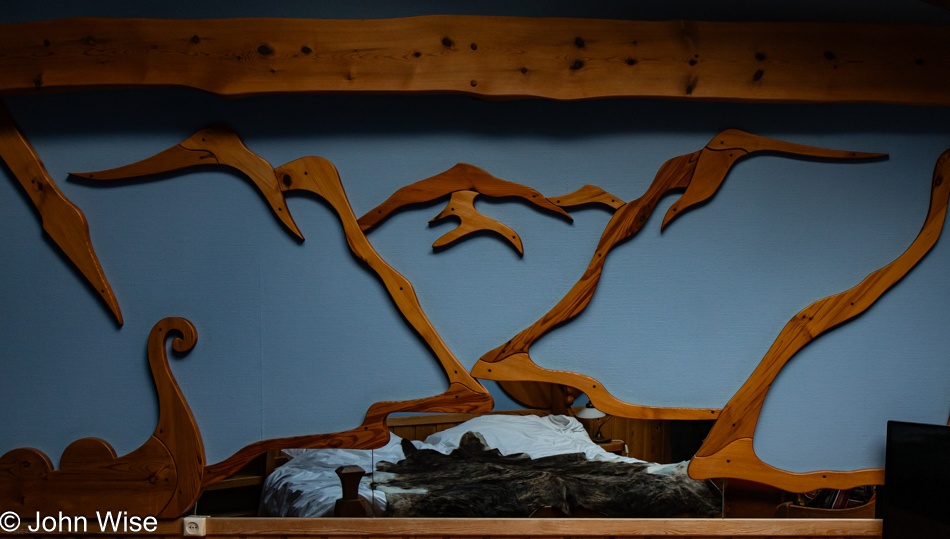
Opposite our Viking bed on the Viking wall was Viking art in the form of a fjord with a strategically placed mirror reflecting our place of sleep, like the waters outside that reflect the sleeping mountains. Was this themed room, the most expensive lodging option of our entire trip, worth the $332 for the night? Absolutely, because more than an idea, Gudvangen was a waypoint along the scenic path we were traveling. Skipping this village and its expense would have meant we’d have skipped Flåm, too, our 2nd most expensive couple of nights. Add to those costs the train rides, cruise, bike rental, restaurants, and all those pølser, and for the resulting total amount, we could have afforded five or six more days in Stockholm or Oslo. But then, what would we have missed? Can we even put a cost on the wealth that experiences offer us? From my point of view, these are priceless moments and food for the imagination. Without them, we’d be poorer in knowledge and potentialities than the money that had to be sacrificed to gather such things.
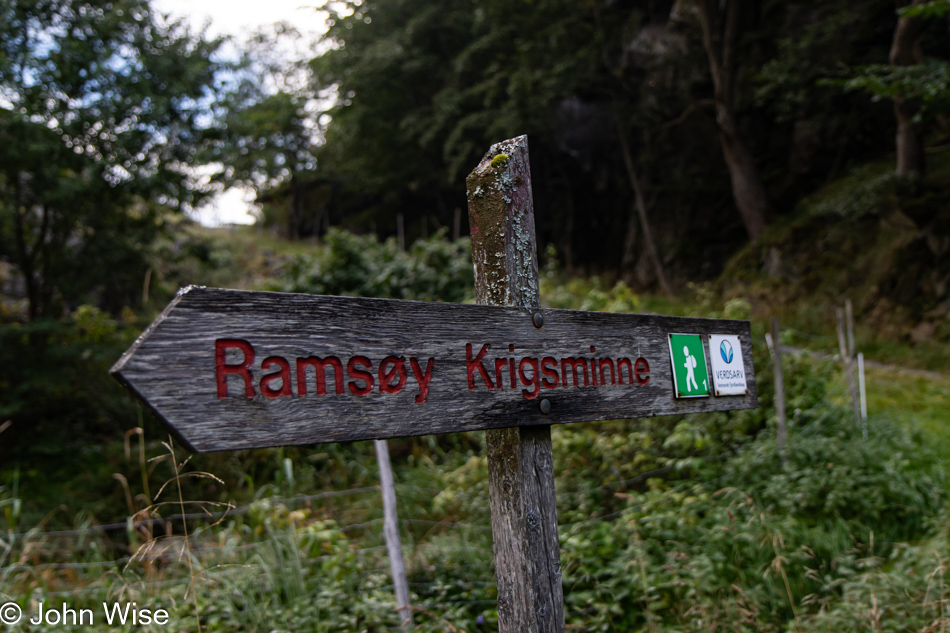
About 80 years ago, some Nazi dickheads set up an armed camp on this vantage point to protect the waterway that allowed travel between the open sea and Gudvangen with its road to Voss and further locations south. Prime Nazi travelway when fighting a World War, I guess.
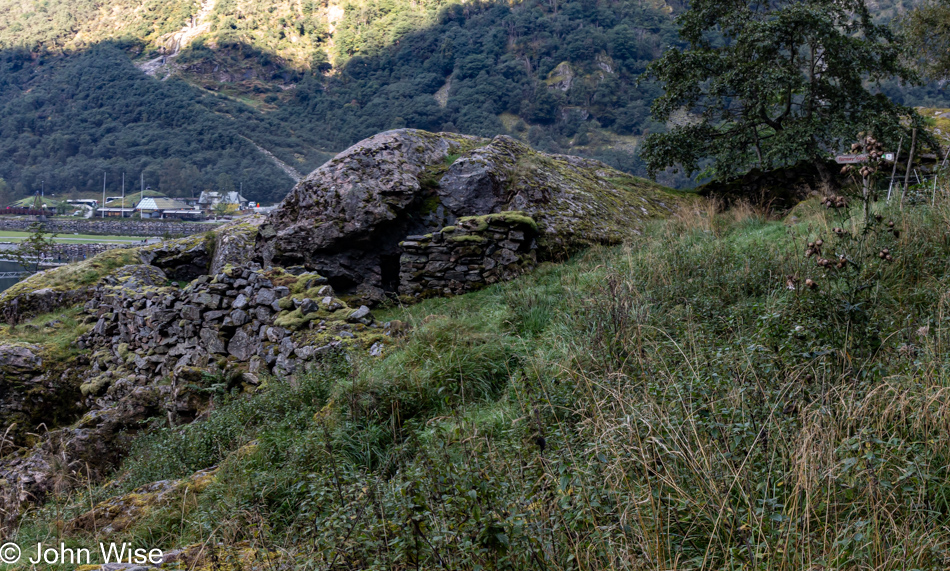
The ruins of the bunker just east of our hotel are called Ramsøy Krigsminne (War Memorial). We didn’t spend much time here as we had a bus to catch. Yet another reason to visit again.
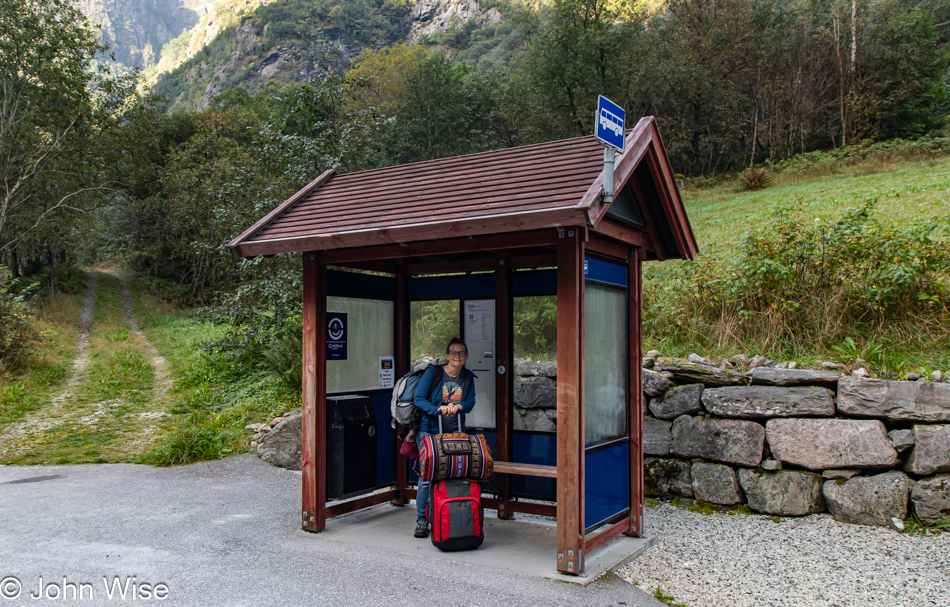
Spending a few weeks in Scandinavia? That is the totality of luggage that we drag around with us, and consider that a large part of the bulk at this time is in the form of yarn while the clothes become more compact the greasier they get. Yep, it’s already been five more days since we were originally going to do laundry, but one has to have priorities, and we are living those.

Photo quality is about to dive because though we are in the front seats of the bus on the right of the driver, this is not the best way to capture scenery, not by a long shot.
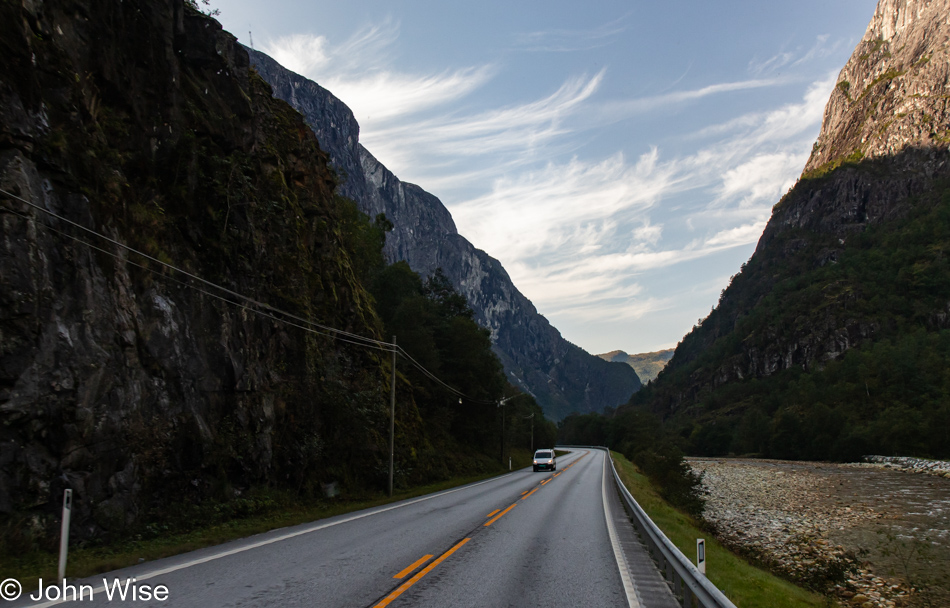
Nærøydalselvi River is there on the right, and we are on our way to Voss, where we’ll have to transfer to another bus.
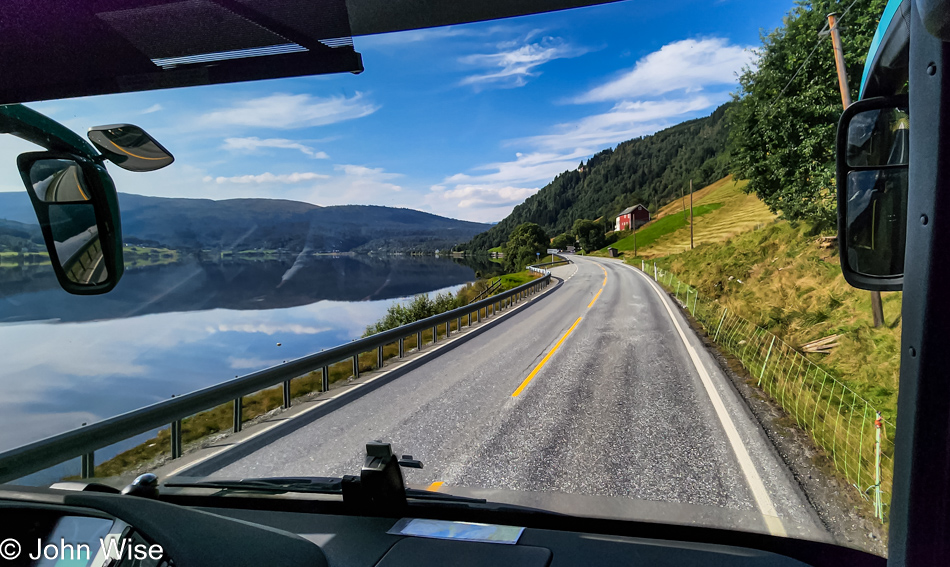
We’ve left Voss, and I was able to capture a half-decent photo of the road ahead with my phone camera. While it looks okay, I know what we lose in quality. But who cares? It helps tell the visual story of our three-hour bus ride south.

Seriously, even with front-row seats on both legs, this was a hard stretch of road to capture decent photos.
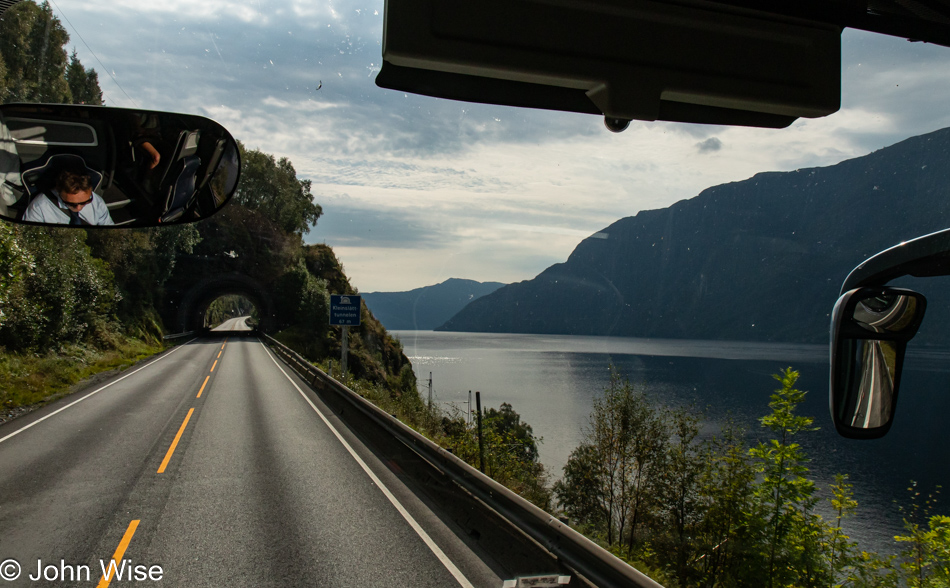
While I’ve read about the rainy days of Bergen, Norway, by this time in my writing, while we were on our way to the city, we had no idea about the poor state of weather they must endure, but we were starting to get hints that our string of blue sky days might be taking a hit.
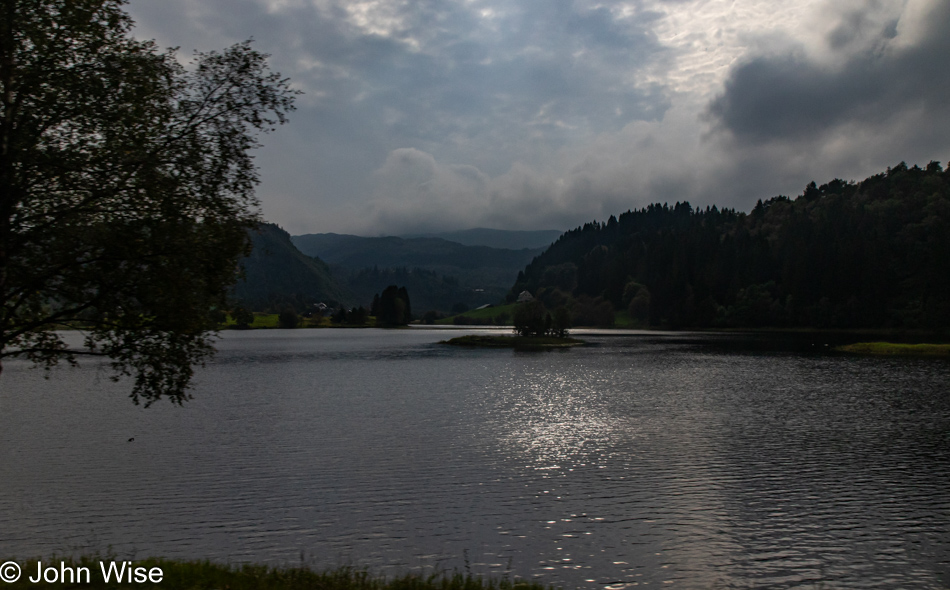
It’s starting to look grim, and we’re not all that far away from Bergen at this point. Fingers are crossed that our Wise Charm will go to work in at least offering us a dry city.
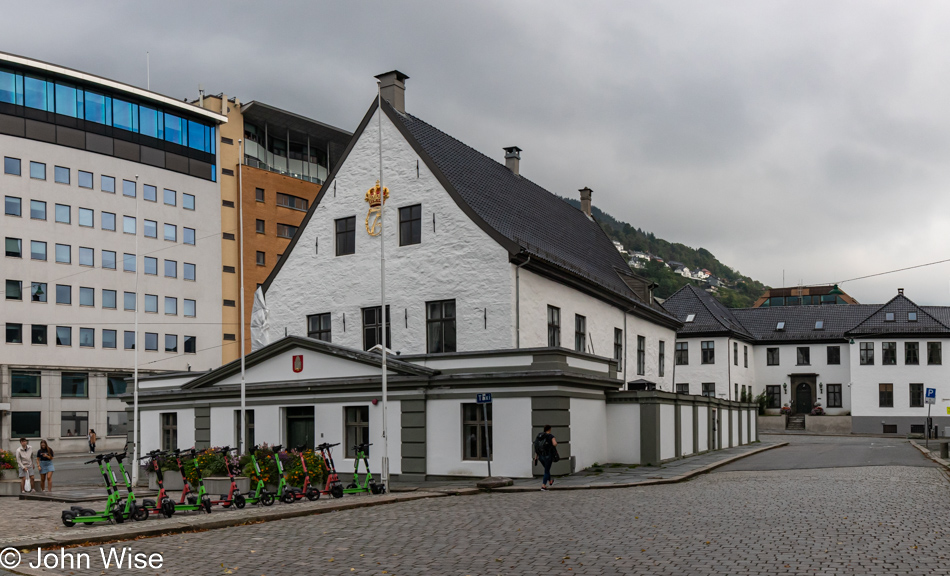
We landed, and our first stop was not here at the Old Town Hall; we were desperate for an electronics store because the memory card in my camera was approaching capacity. Just how I thought one 256GB card would be enough before leaving the States is a mystery of oversight that was corrected on our way out of the train station. Dragging our bags to the third or fourth floor of a mall wasn’t fun, and only finding 64GB cards felt like a waste of money considering the half-dozen or so of those we have at home, but so it goes, I wasn’t ready to stop taking photos or turning to rely on my phone with its weird HDR like impressions. If the world is cold and gray, it’s okay that images are not candy-colored saturations of silliness that make people happier because things appear better than they might have been. [We had been looking for a memory card for a while now, but rural Norway is not a great place to shop for electronics. The gift store in Flåm had only 8GB cards, which made us and the salesperson laugh. They probably had been sitting there for a while. Caroline]
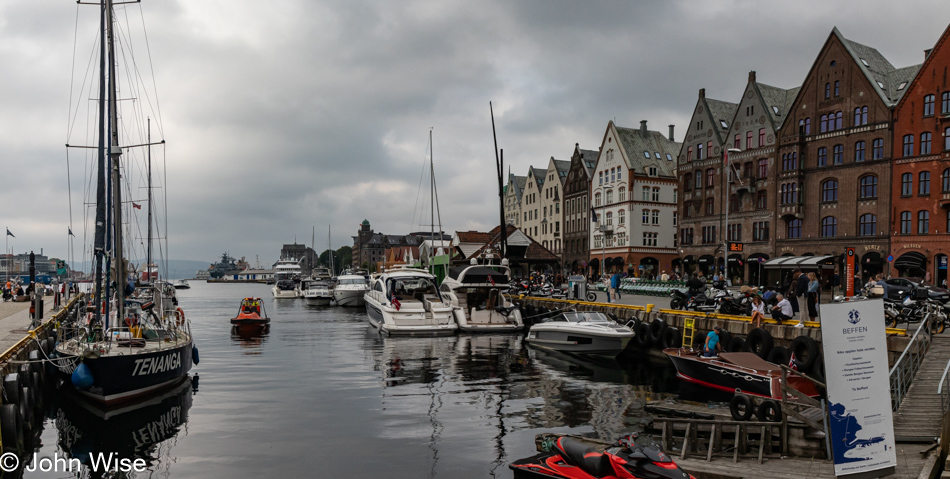
Somehow, we snagged a relatively inexpensive room here at the old wharf known as the Bryggen area with a great view overlooking the port. Counting roofs from the right, it’s the third house, this side of the white building.
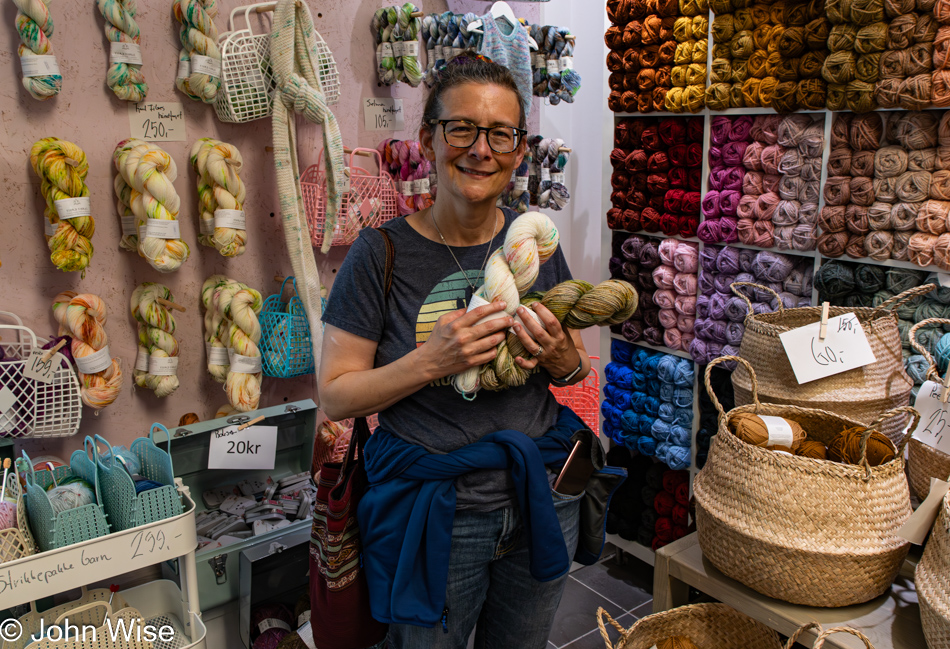
After dumping our bags at the hotel, it was off to the yarn store called Strikkelykke. We needed to be quick about it as this being Saturday, they close at 4:00 p.m., and we’d just arrived at 3:00 p.m. in Bergen. For those who want to know, this is our 8th yarn store in 14 days. Unfortunately, three stores were missed as time wasn’t always in our favor.
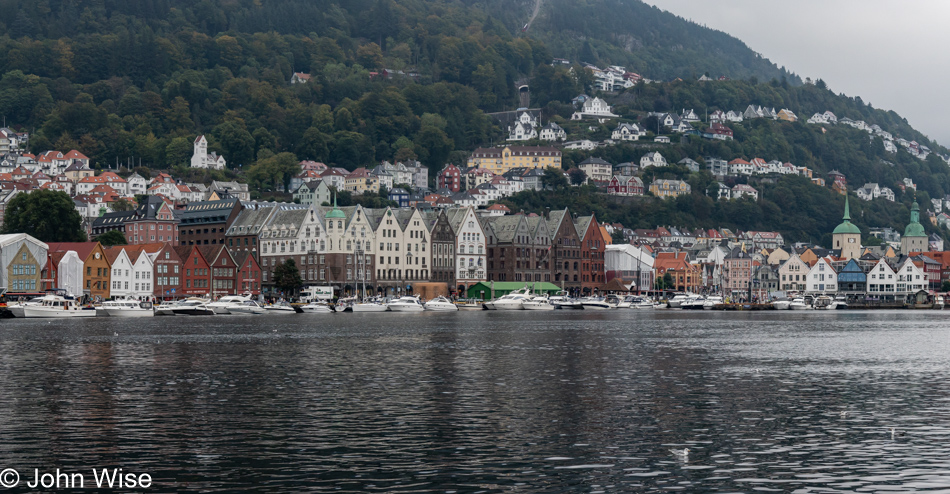
We’ll get this weather report out of the way right now: we will not see the sun while in Bergen, which is absolutely normal as this is one wet city. While I had been looking forward to a couple of down days due to torrential rain, it won’t be as bad as all that. The reason behind my wish for rain is that after a go-go-go amount of travel, it’s nice to shut down a bit in a coffee shop and catch up on writing while Caroline gets busy with the knitting and the two of us are finally face-to-face and can smile at each other instead of always being side-by-side, though the perk there is we get to hold hands.
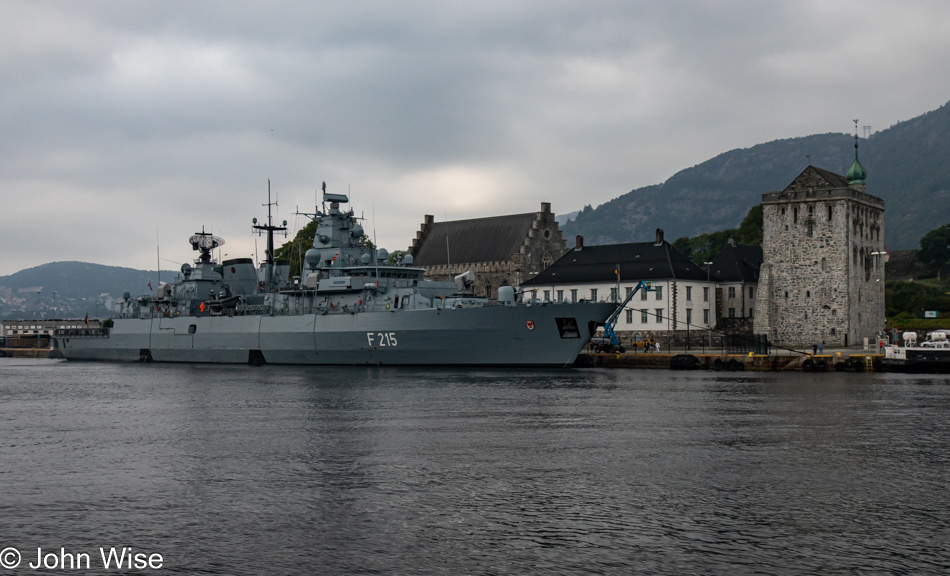
Eighty years later, a German Navy is moored in port, part of a peaceful collaboration where neighbors work with one another instead of dominating and murdering.
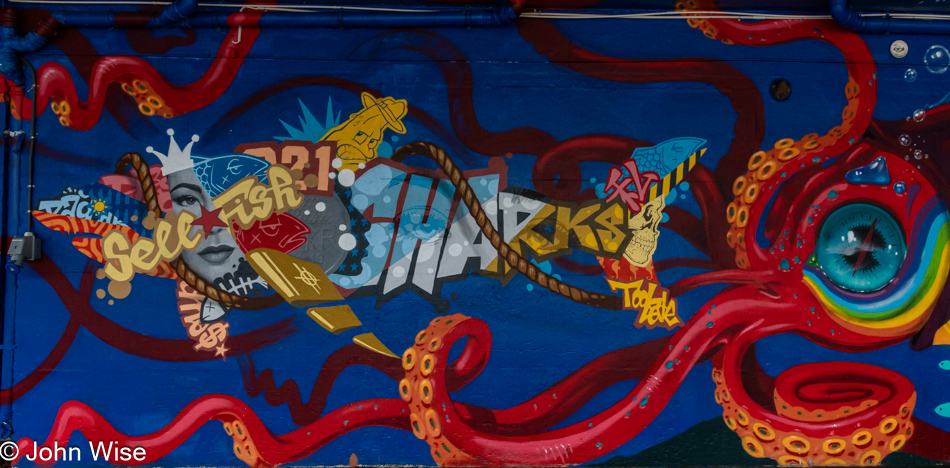
I’ll notice something while we are here that mirrors other rainy gray cities we’ve visited, and that’s the abundance of murals and other street art.
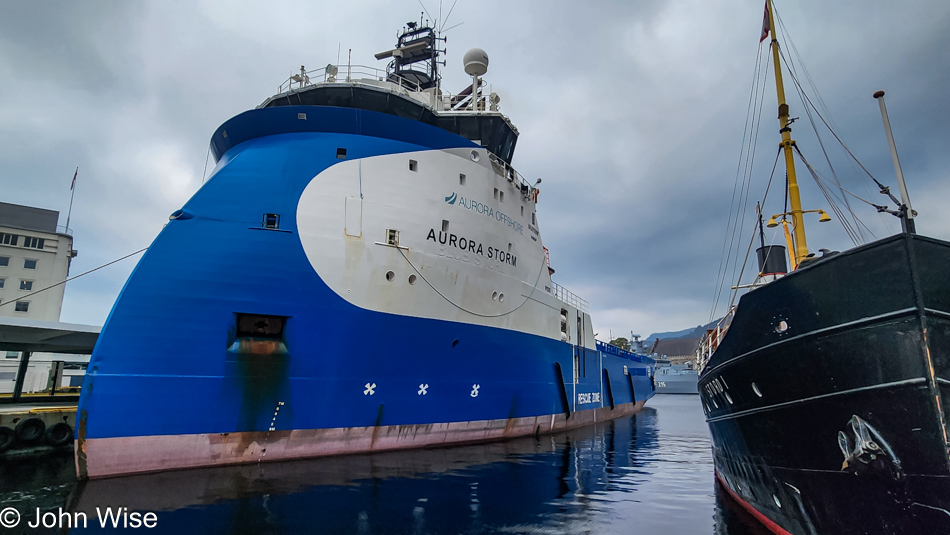
This oddly shaped ship called the Aurora Storm is what is known as an offshore supply ship that services oil and gas platforms out on the North Sea.
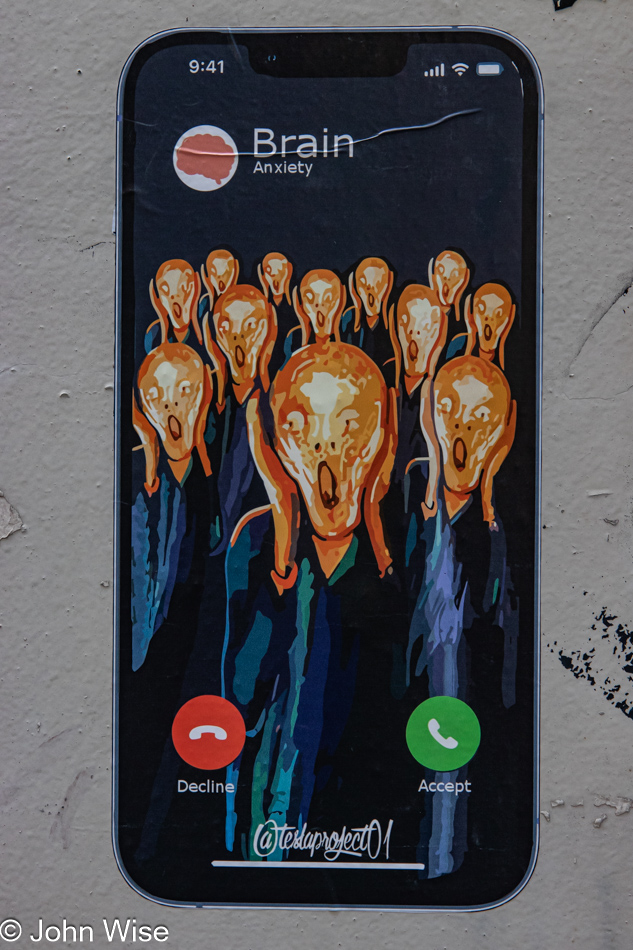
Leave it to the Europeans to point out the obvious that also reflects their tenuous relationship with technology, especially ones that can surveil them.
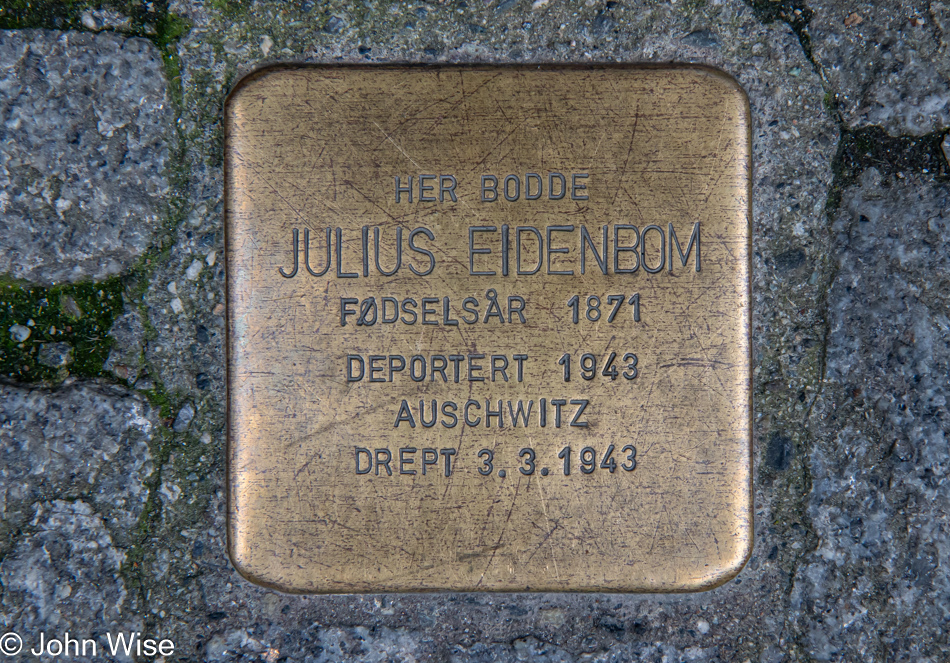
And just why might Europeans be leery about surveilling people and collecting data on them? Maybe it, in part, relates to the time when Jews were snatched from their homes and sent to die in a concentration camp such as Auschwitz. Stumbling Stones are found in 24 countries across Europe, including Russia, and I think they are a powerful reminder to not let any groups fall under the scrutiny of the state. Rest in peace, Mr. Julius Eidenbom.
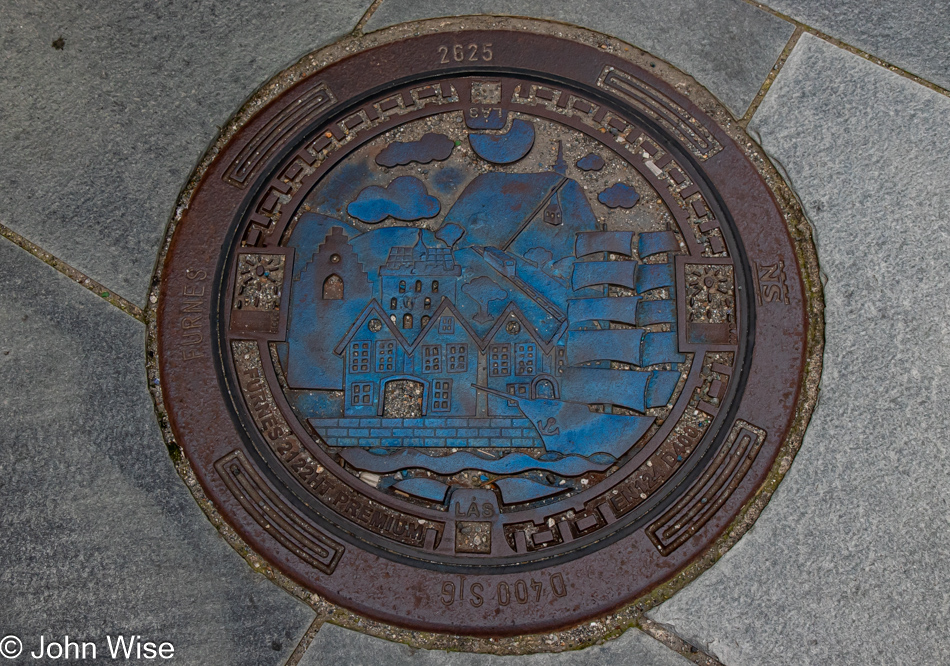
Not a Stumbling Stone.
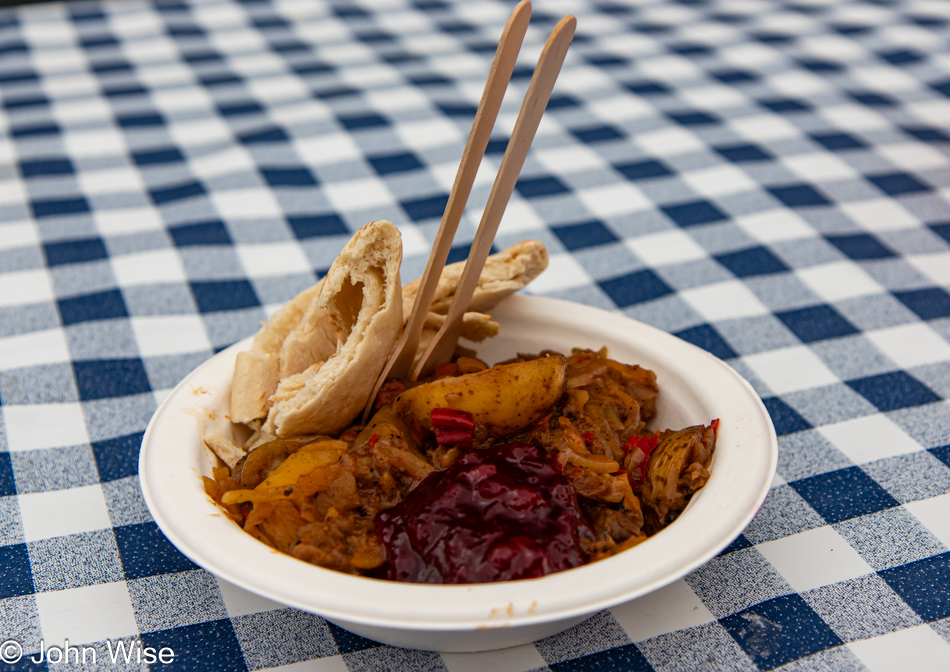
At the Fish Market, we were looking for a bite to eat, something we could share but that wouldn’t interfere with our dinner reservations later in the day. We decided on a food stand called Kystvilt, which was serving up moose and wild deer; we opted for the moose stew. Note the paper bowl and wooden utensils; Scandinavia is taking seriously the need to recycle and cut back on packaging that’s detrimental to the environment. As for the moose, it did not taste like chicken, more like beef, I suppose, though pulling the individual flavor out of the stew wasn’t easy. I’m guessing that moose meat is especially lean and that the ample amount of onions and veggies, along with a judicious amount of fat, went far to make it a lot more savory than it might have otherwise been; add in a dollop of lingonberry and Bob’s your uncle.
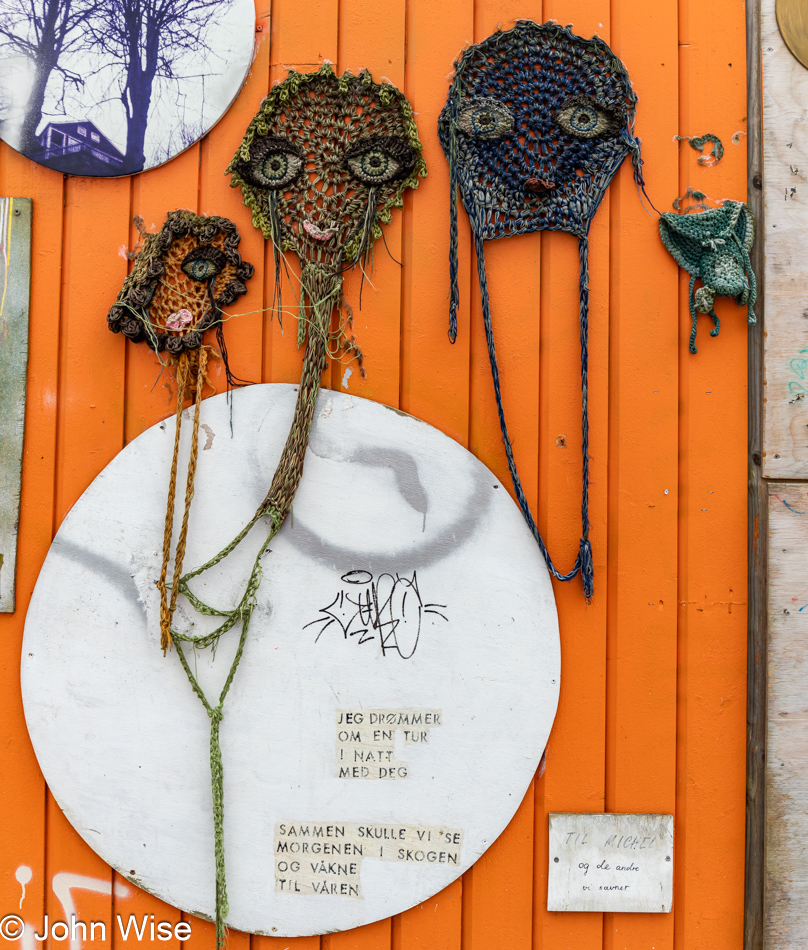
Walking out of the Fish Market, we encountered several vendors offering whale burgers, but this created a conundrum for us as, yes, our curiosity wanted to know what it’s like, but then we would have to live with the memory, and we would have also added a tiny bit more to the demand for the harvesting of whales. Unable to fully contain ourselves, we tried a smidge of whale sausage that ended up tasting exactly like pork sausage. Street art does not kill whales.

The Bergen Cathedral was supposed to still be open, but at 5:05 p.m., it was closed as closed gets. If the church had been open, I might have been more surprised as, if nothing else, we should have learned by now that Scandinavian sites have strict opening hours.
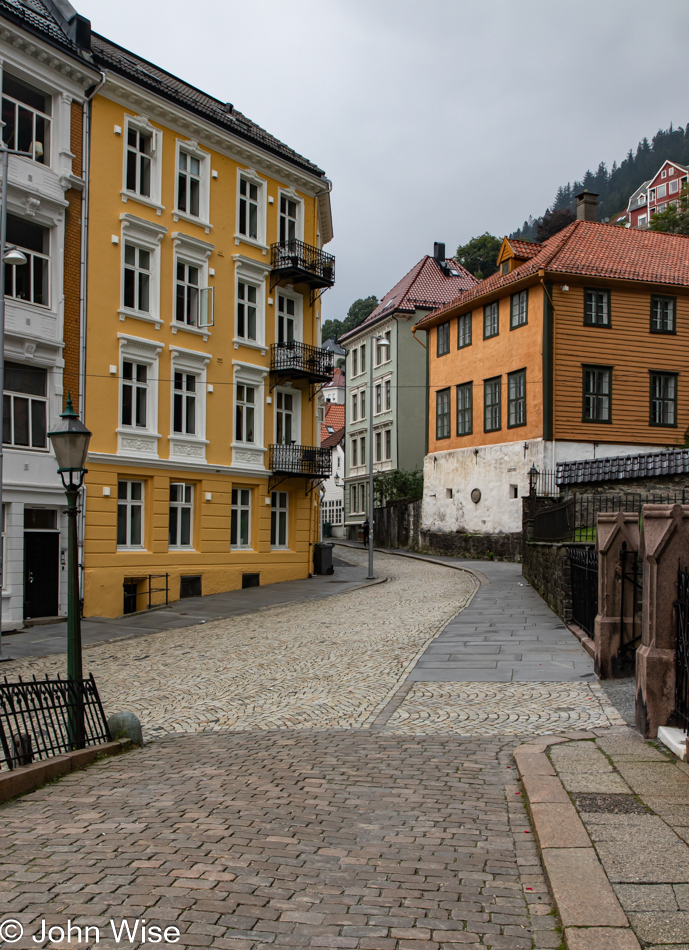
Caroline sees that the 9th yarn store is open for another 55 minutes and that we can easily make it over to the main train station, which is right next to where we came into town with the bus but were in a hurry to get that memory card and get to Strikkelykke (I pronounce it Sticky-Licky regardless if it’s correct) due to it closing early on Saturday and fully closed on Sunday.

Brightening gray days with an abundance of art are starting to make Bergen feel very progressive, but who knows? Two brief hours in most cities will tell very little about the underlying climate of minds, culture, and attitudes.
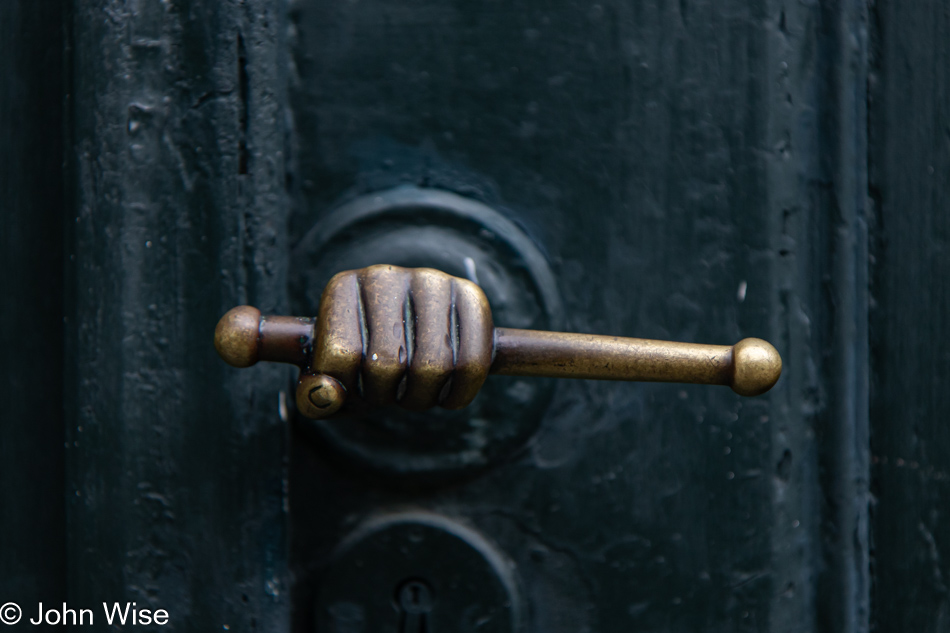
Passing the Leprosy Museum and saw this door handle that demands we embrace the other’s hand.

Mixing things up here at the Norwegian Spirit Knitting & Yarn store by having Caroline take my photo with the yarn I’ve chosen for a new pair of socks. Our brief stop at this yarn store was extended after we met Katrine, who was watching the shop. She talked to us about her visits to EuroDisney, Disneyland, Disney Tokyo, and Disneyworld. Part of her study in economics had her in Paris, France, for a year though she doesn’t speak French, yet she’s fluent in Norwegian, English, Italian, and Spanish. Tragically, Caroline wasn’t ready to choose the yarn she wanted, and plans were made to return on Monday, but things got away from us, and instead of fretting about the loss, I’m encouraging her to order that locally-dyed yarn online so there are no regrets. Just do it, Caroline.
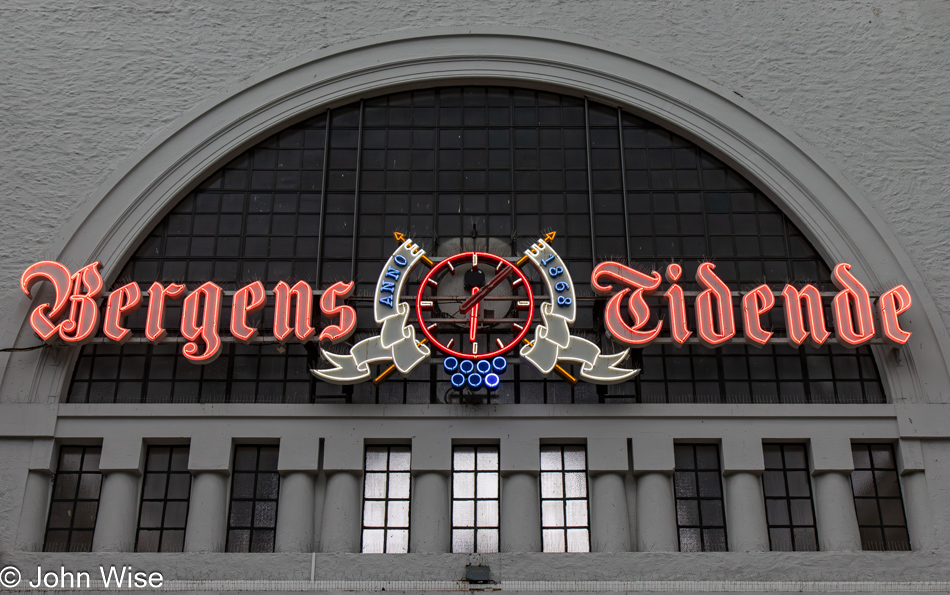
Out of the yarn store and back into the train station because, strangely enough, the shop is near the train tracks. We’ve now been in Bergen for three hours, as you can read on the face of the clock.

Not only do loads of street art abound, but statues are ubiquitous too, such as this one of composer Edvard Grieg, who wrote In the Hall of the Mountain King for the play titled Peer Gynt by another Bergen local named Henrik Ibsen. While you may not know the title, you know the piece; I’m 100% certain you do.
Side note to Caroline, who’ll understand the reference: Grieg canceled his 1899 concerts in France in protest of the Dreyfus affair.
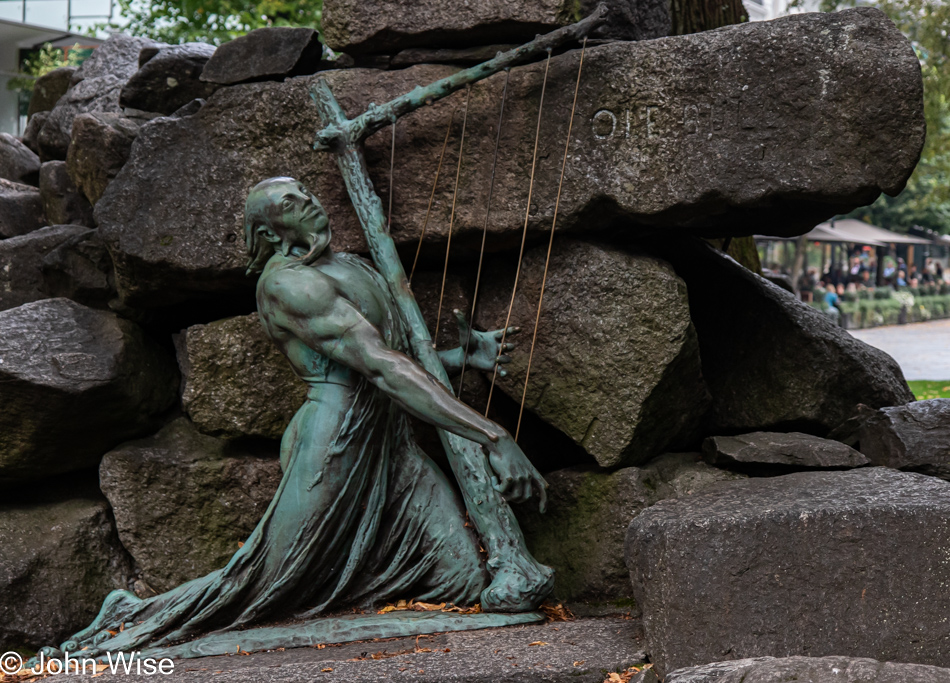
Fossegrim plays the strings for Ole Bull, who is part of the statue above this water spirit. Ole Bull, who the surrounding square is named after was a virtuoso violinist and composer from Bergen. [Fossegrim in Norse mythology is a water spirit that also plays music in an enchanting way. Caroline]

Ole Bull’s Plass or Ole Bull’s Square is also where you’ll find this statue, Lying Poet, by Hans Jacob Meyer.
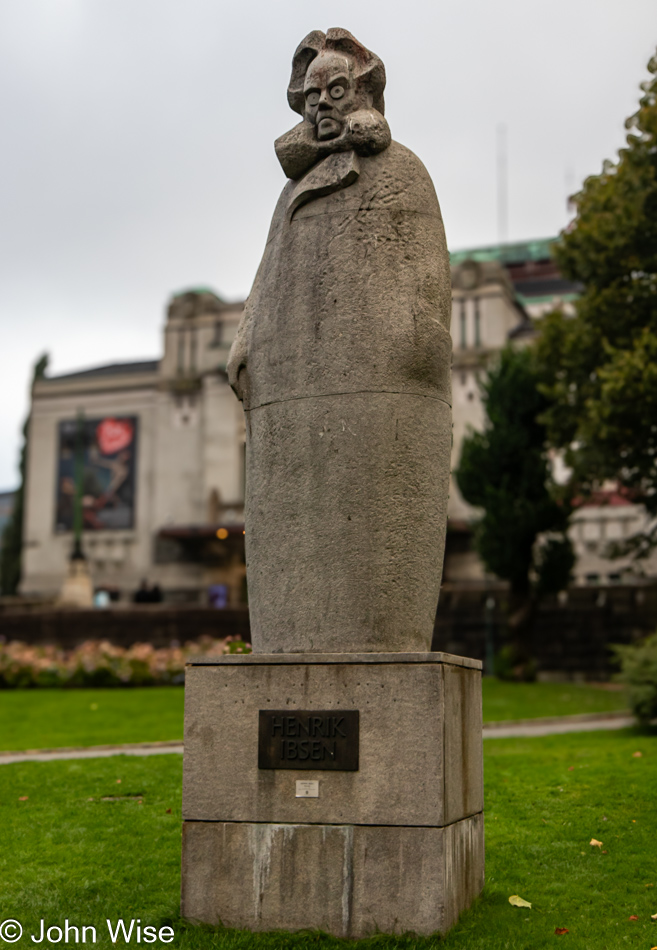
This crazy-eyed statue honors Henrik Ibsen, the famous playwright and poet.
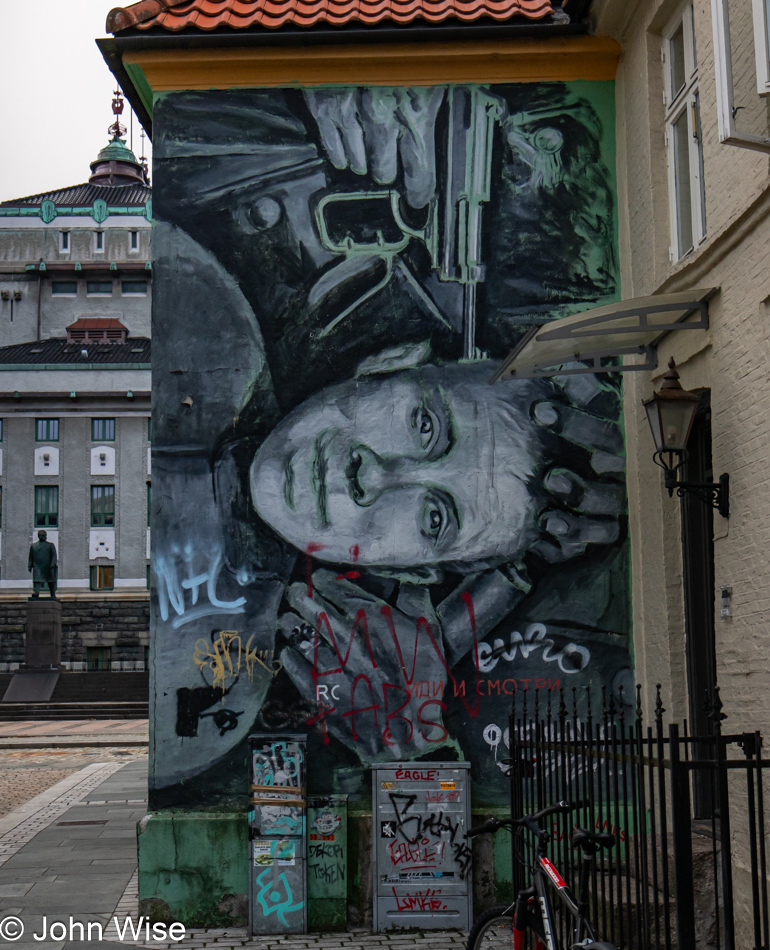
This mural will be known by some at first glance, but for those who don’t know the reference, the image is from the amazing 1985 Soviet film Come and See.
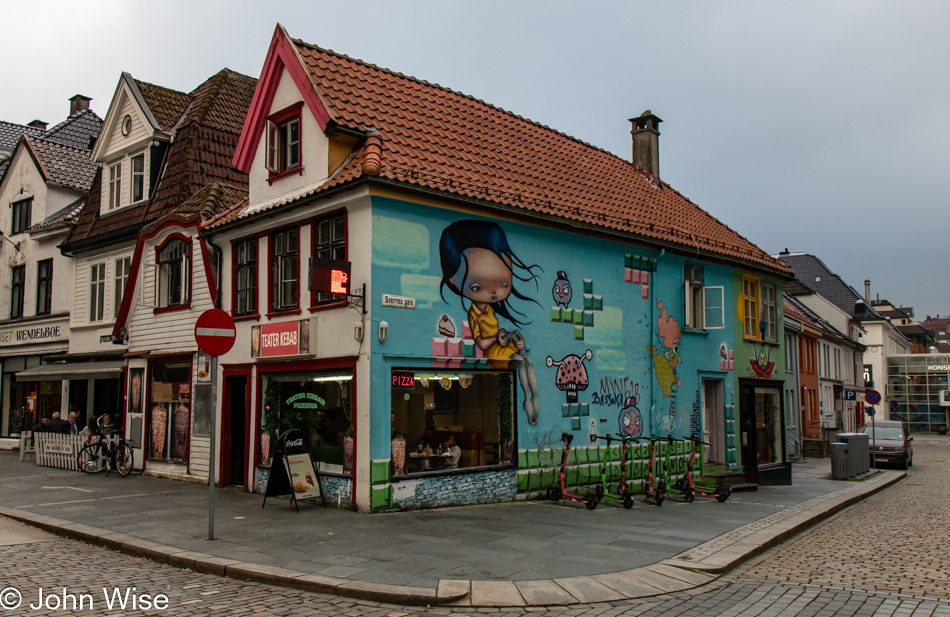
Consistent with what I learned during my own time living in Europe, where rain and gray skies prevail, art and culture are the go-to activities that one can do and create indoors when spending time outside in the sun is curtailed by the circumstances of the weather.
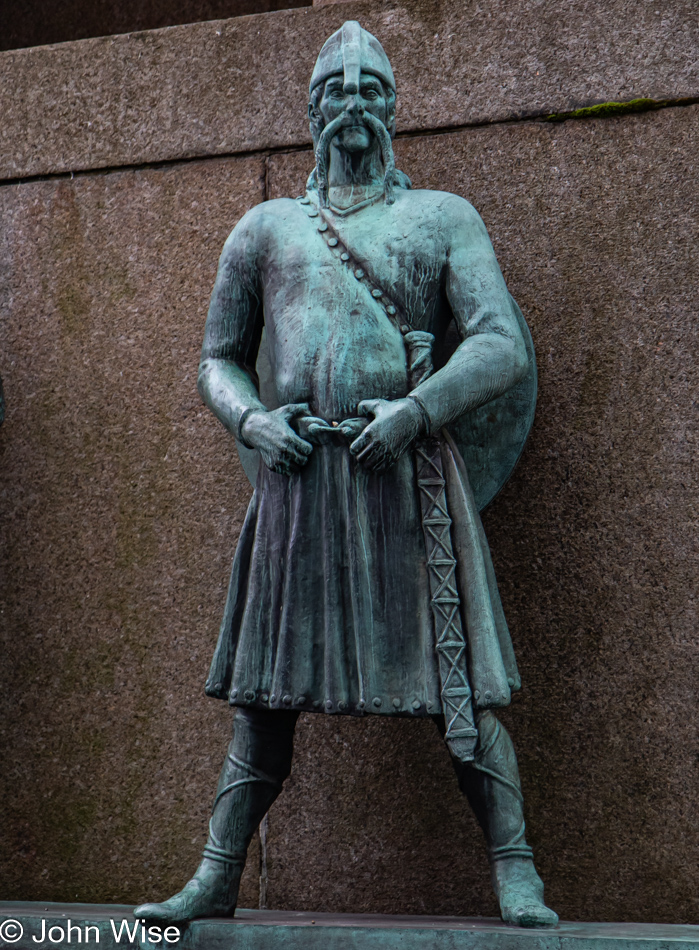
Continuing our meander through town, trying to follow visual cues that would keep our walk interesting, we arrived at the Seamen’s Monument, which was created fairly recently, back in 1950. This Viking is but one of twelve larger sculptures around the monument featuring variations on the theme of seafarers.
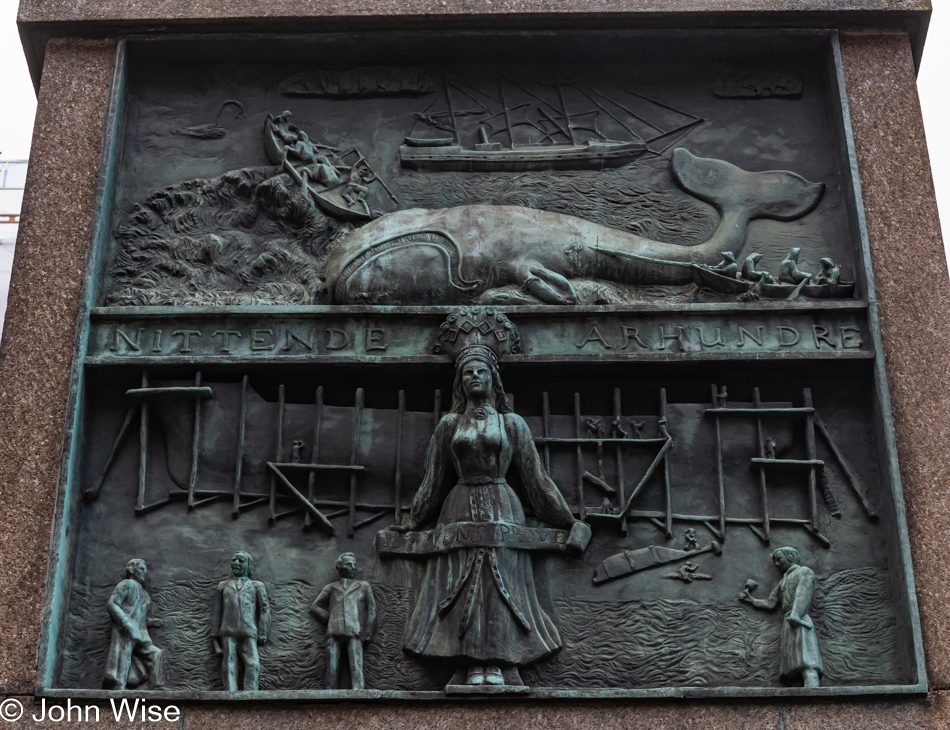
Four panels around the top of the monument represent the major eras of Norway’s relationship to the sea.

Born in Bergen, the writer, essayist, philosopher, historian, and playwright Ludvig Holberg is memorialized here to inspire others to take a page from this creative font. Holberg is known to have traveled to the Netherlands, France, England, and Italy, with Paris, Oxford, and Rome having a great influence on him. While he studied theology at university, he was self-taught in languages, history, and law. The University of Copenhagen used his materials for nearly 200 years for students studying law. As a playwright, his influence came from Parisian comedies and street theater he watched while in Rome. Today, Tiktokers travel the world and grunt approval of mixed drinks, pose in iconic locations during sunset, and offer exuberant endorsements of how amazing the place is, but rarely, if ever, have anything to say, so I doubt we’ll ever see a monument to a TikTok personality/influencer.
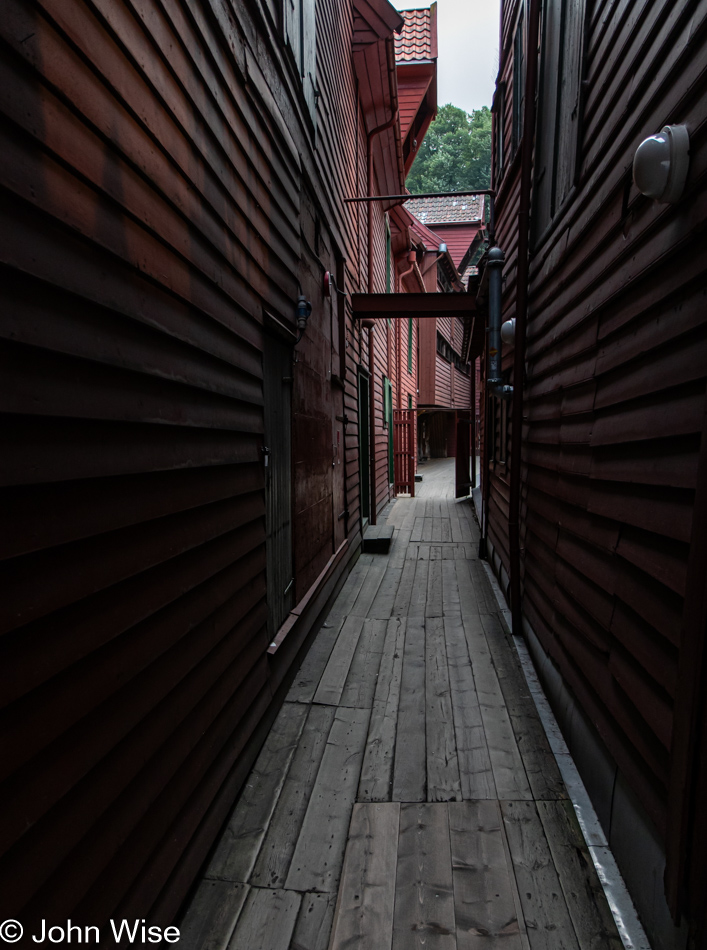
It was the dreaded Germans and their Hanseatic League monopoly that carved out the historic Bryggen area here in Bergen, which was their protected trade area, but more of that tomorrow when we get a tour of the historic buildings. That these old bits of wooden history still exist seems like an incredible stroke of luck and proper fire prevention measures.
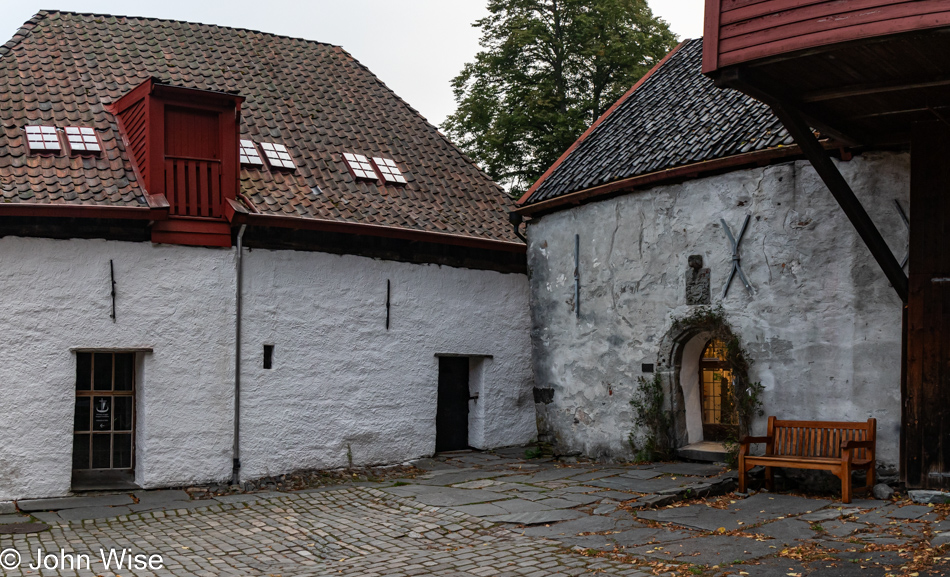
With some time to spare before our dinner reservation, we continued to explore the grounds of the Hanseatic League.
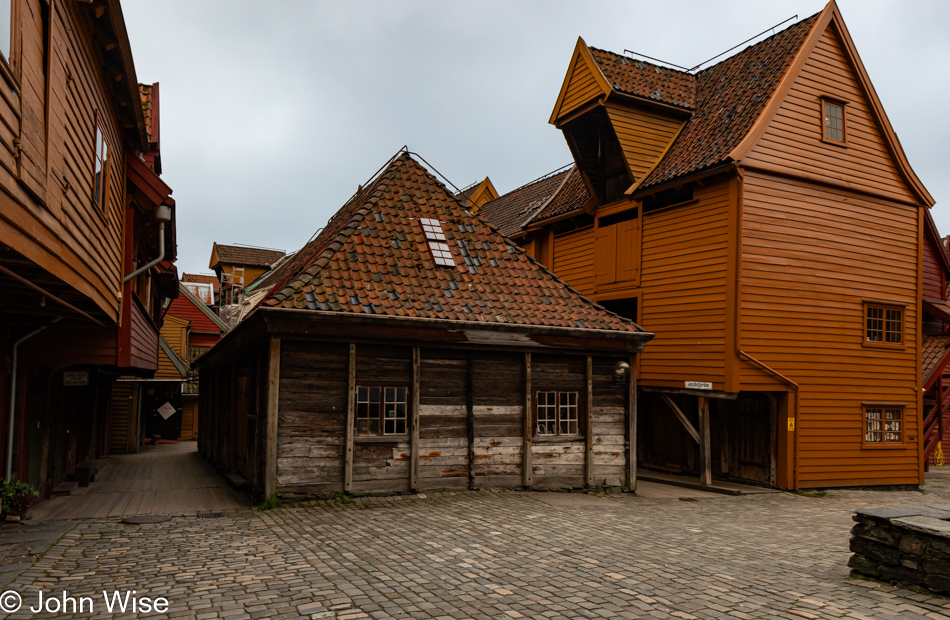
How many days or weeks would one have to hang out in Bergen to capture the sights on a sunny day? I’d wager that it might be a good long time, considering the 239 days of rain this city gets.

One has to wonder, seeing how America has tried to make everything handicap accessible, how these old European towns can offer much of anything to those who must get around on wheelchairs or walkers. Throughout our visit to Bergen, we’d see firsthand the difficulties for the mobility impaired as elderly Americans disembark cruise ships and become frustrated with cobblestones and stairs.
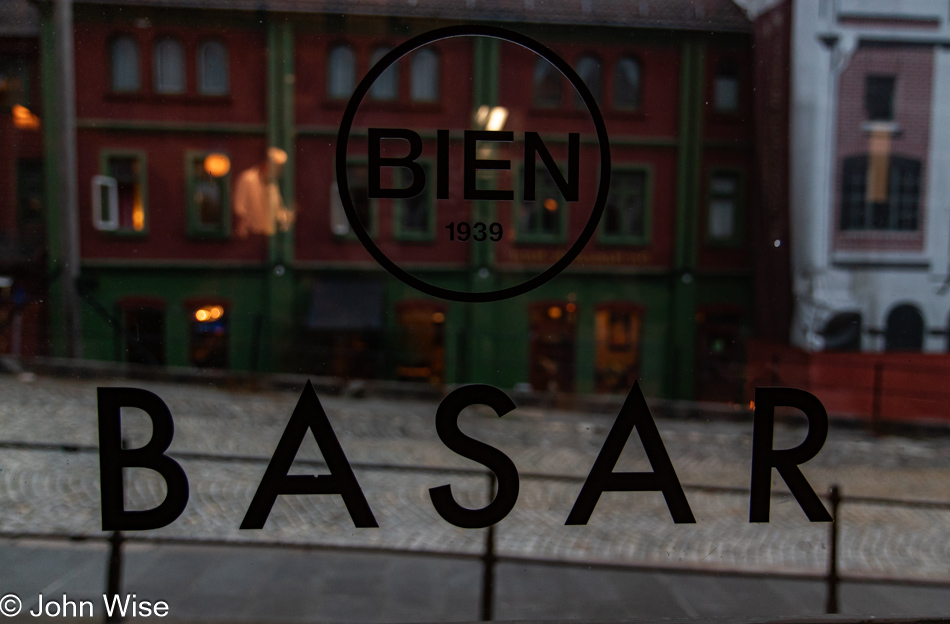
Time for one of my more anticipated reservations, this one at Bien Basar. In researching where we’d be going and what we should be trying while in Scandinavia, I learned of a traditional dish here in Bergen that originates from right here, Persetorsk. Just as Pinnekjøtt (cured lamb ribs) is a Christmas fav in Oslo, here in Bergen, Persetorsk (pressed cod) is the go-to dish. Lucky for us, I found Bien Basar, which appears to serve Persetorsk year-round for us tourists/travelers who can’t be here during the winter holiday season.
Before dipping into our main course, you must know by now that if a menu features tartar, we are sharing an appetizer of raw beef, and that’s just how this meal started this evening. I felt like it was just too odd for the both of us to have the same dish for dinner, so I opted for the Sei (pollack), which looked intriguing enough while Caroline was going to take possession of the Persetorsk. I regretted my decision right away, not that my dish wasn’t everything I could have hoped for, but the pressed cod and especially the perfectly pureed peas were next-level phenomenal, so much so that I’m certain we’ll return so I can experience an entire Persetorsk all to my self.
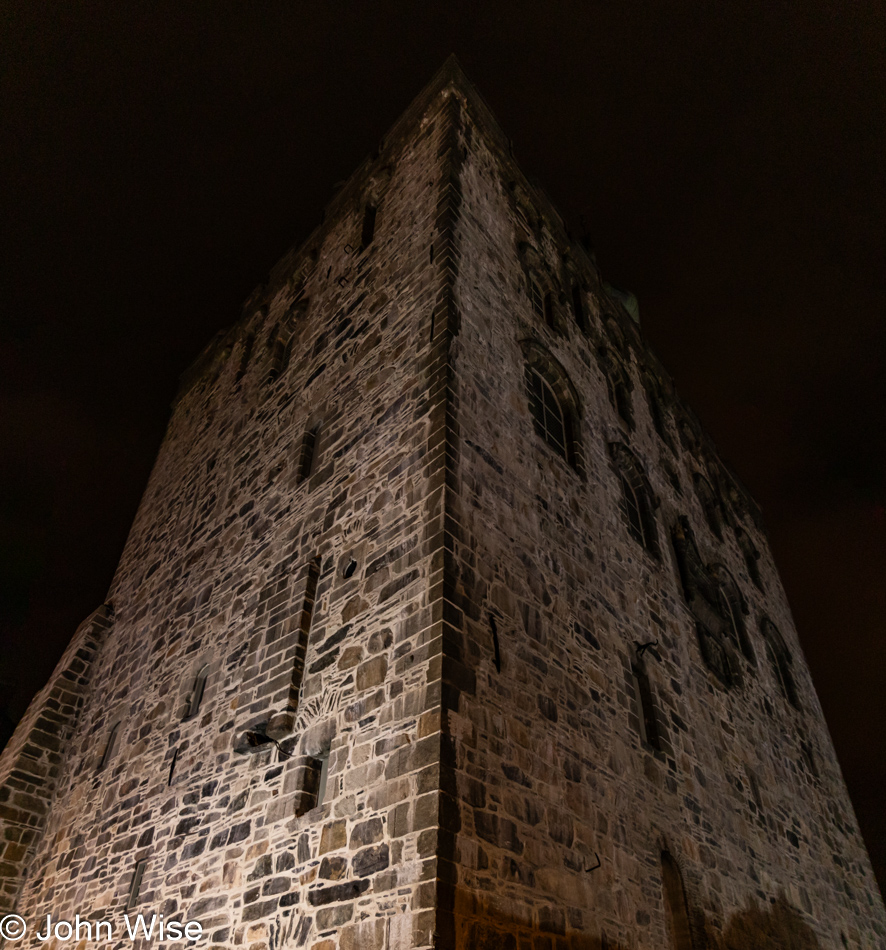
This is Rosenkrantz Tower at Bergenhus Fortress. To our great surprise, the grounds were wide open without guards, which left us feeling like we were intruding and that, at any time, someone would show up demanding to know why were here after hours.
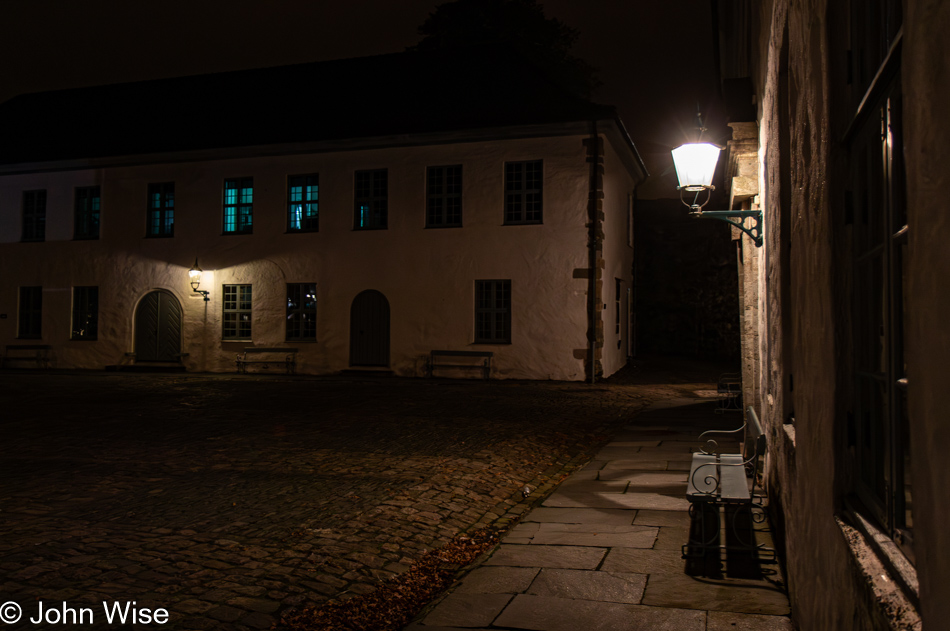
This is a tough one to divorce ourselves from as it’s dark, and there is nobody else here. We have become too aware of the fear of the unknown. Things would be fine if we knew that the place would remain quiet and peaceful, but coming from the States, we are conditioned to believe that danger is lurking just around the corner. This is Norway, though, and no junkies are sleeping nearby, nor gang members loitering, waiting for victims to make themselves known.
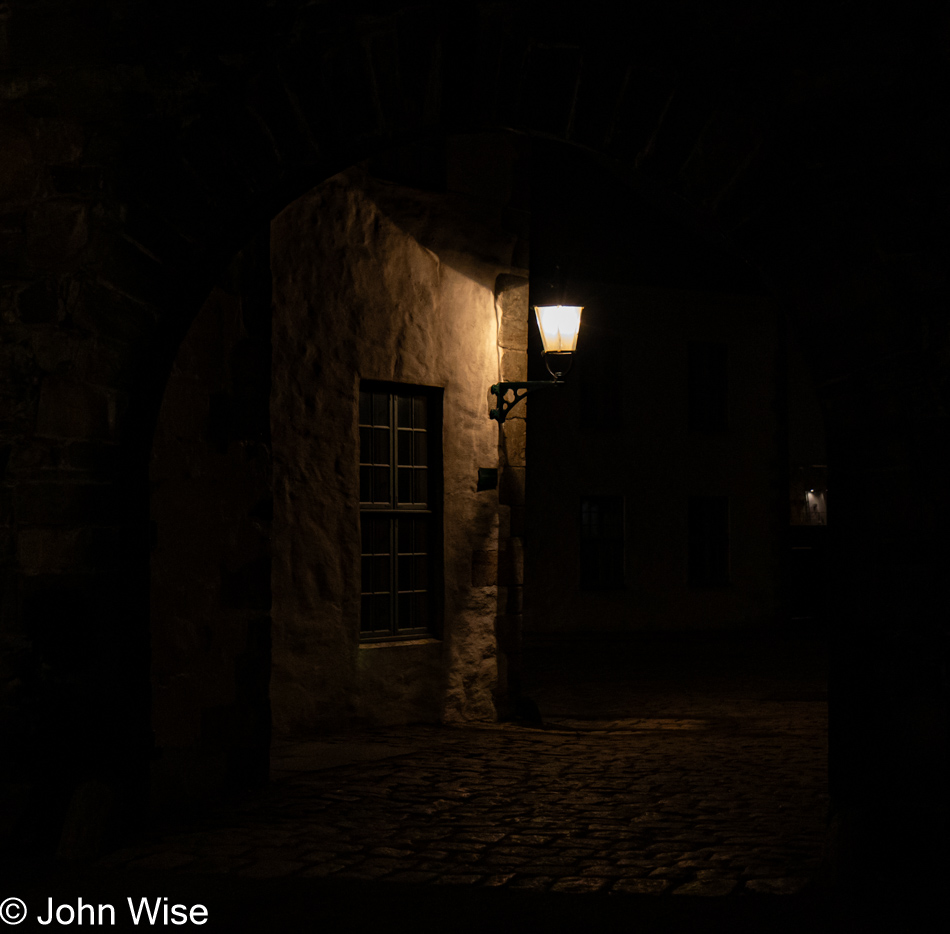
The ambiance to be had here at the fortress is amazing since it’s easy to transport ourselves back in time. However, we were never able to shake the sense that some security person would show up and shoo us away.
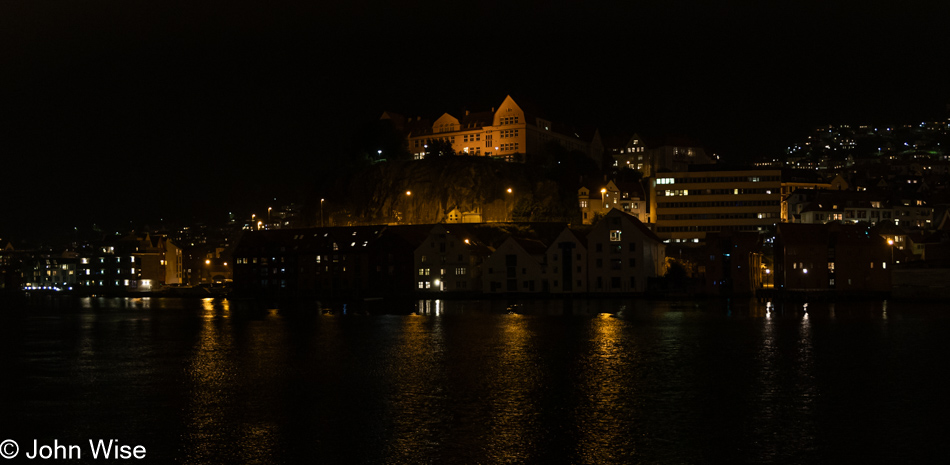
From the fortress, we continued our walk towards the mouth of the harbor, where we gained this view of another side of Bergen we couldn’t see from the Brygga area. We are in the Skuteviken neighborhood, which will lead us to the Sandviken neighborhood, though there’s a chance it’s one or the other or neither. Where precisely we are doesn’t matter, but we can both assure you that it’s a beautiful area away from the well-trafficked tourist haunts.
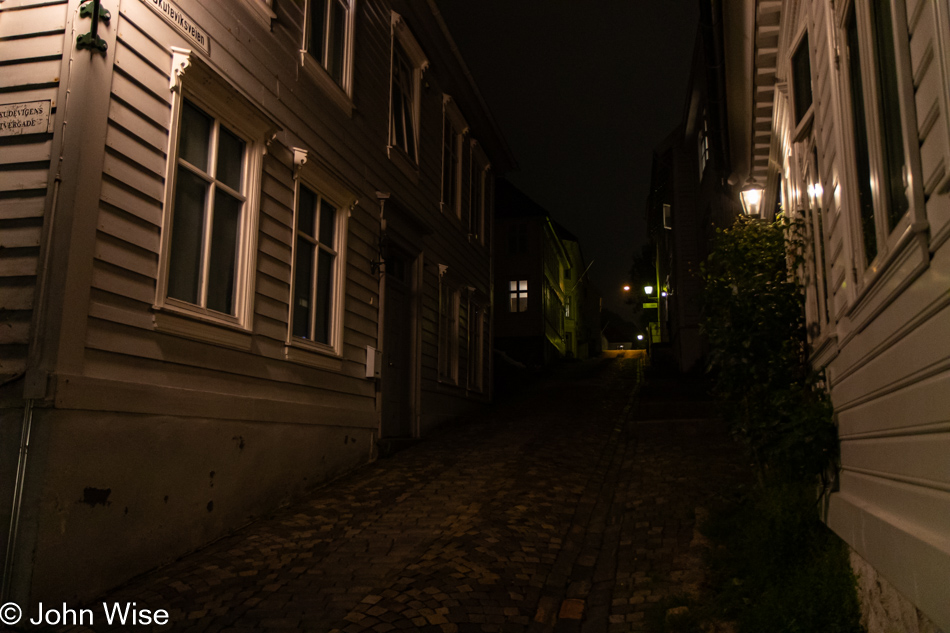
Walking up Skuteviksveien Street will turn out to be the best path to finish our first night in Bergen.
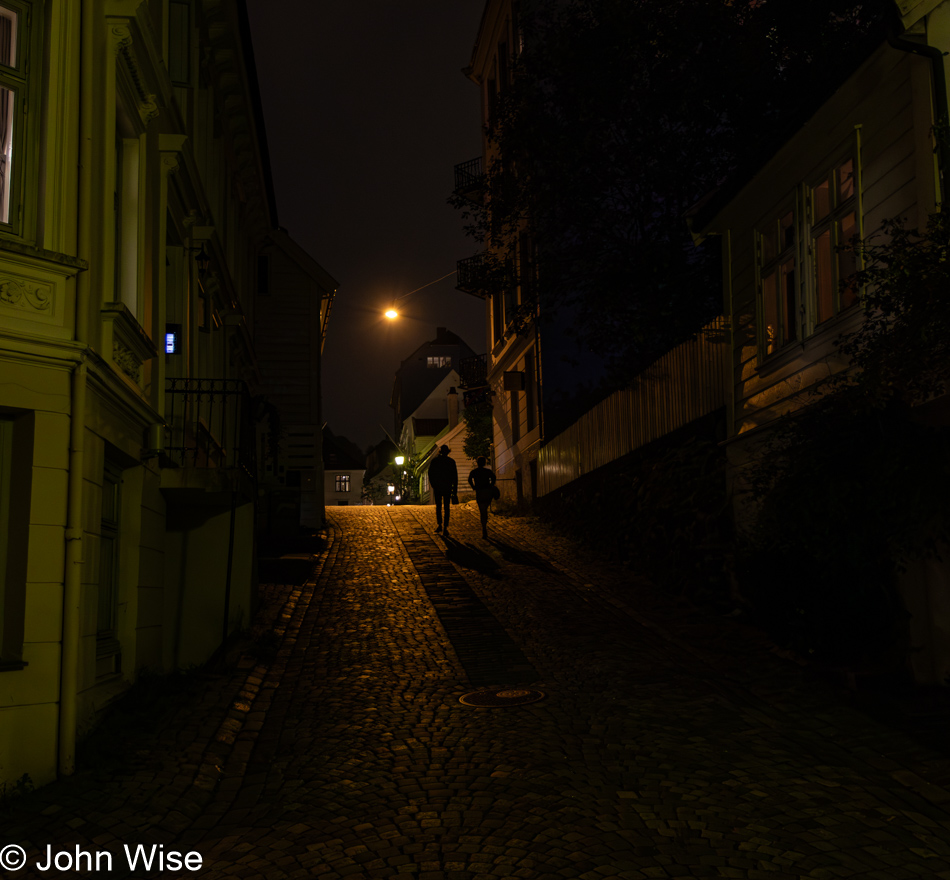
What is here on these dark streets without cars is the sound of voices joined in song wafting out of unseen open windows where a bunch of friends had gotten together for what might have been a small party. It was in Sweden where we first encountered this phenomenon of people singing in groups, which struck us as something incredibly wholesome. Tonight, it doesn’t feel any different.
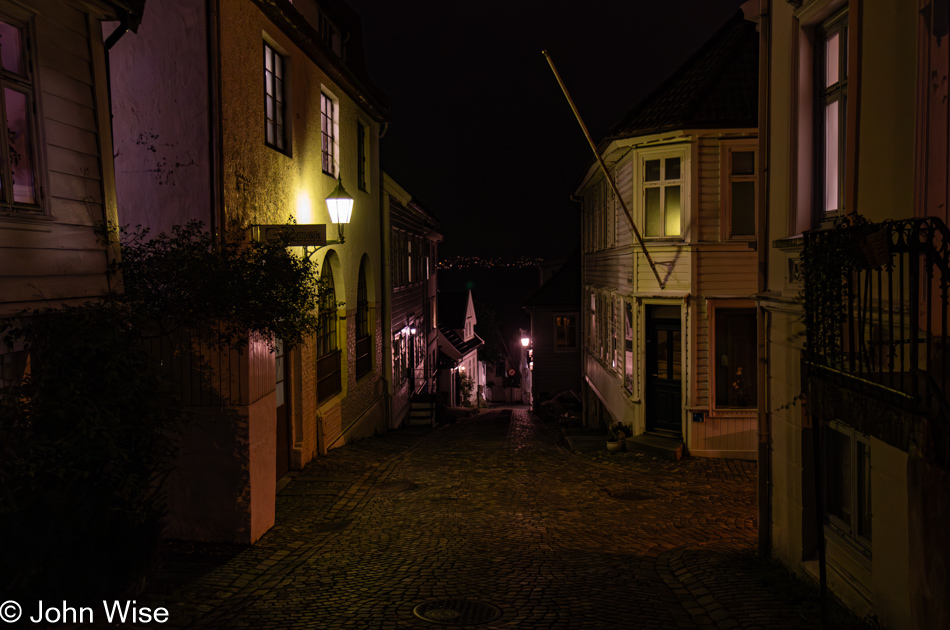
It seems we can’t walk more than 50 meters (150 feet) before hearing another group of people around a corner enthusiastically knocking out a song. Maybe if I consider this as a tradition that became a year-round activity to combat the cold short days of winter and the blues that would accompany that time of the season, it would make sense that something that brings joy should be practiced all the time, but I don’t really know. No matter what drives this shared performance with the neighborhood, it puts smiles on our faces, filling out that part of our grins that aren’t being activated by the architecture that has an incredibly cozy feel.
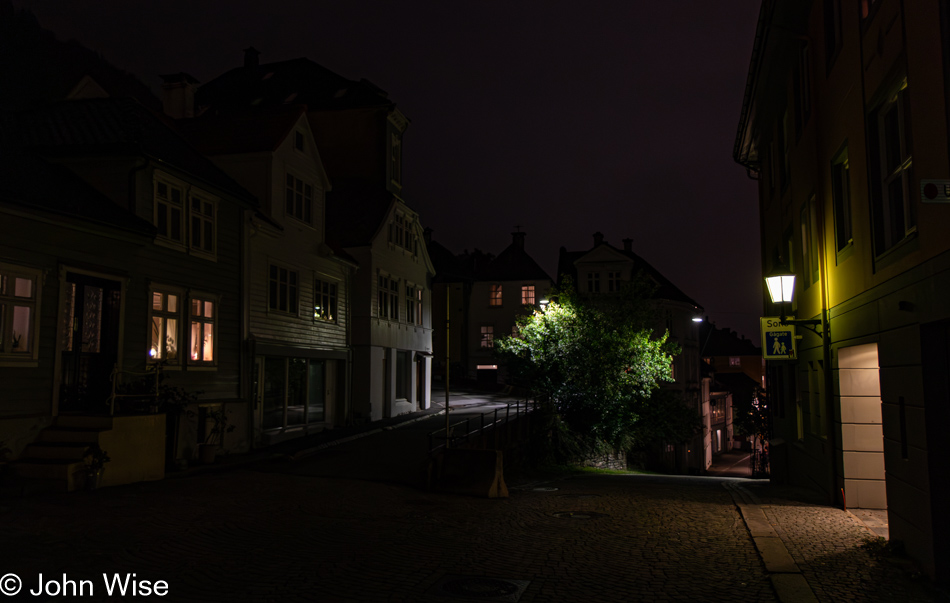
Another distinction between “Most Anywhere America” and the quiet streets of Bergen is that when walking by dwellings, the blue glow and corner of a big screen TV is missing here; warm light prevails with that everpresent sound of singing instead of the (to us) more familiar soundtrack of a movie or sports spilling into the environment.
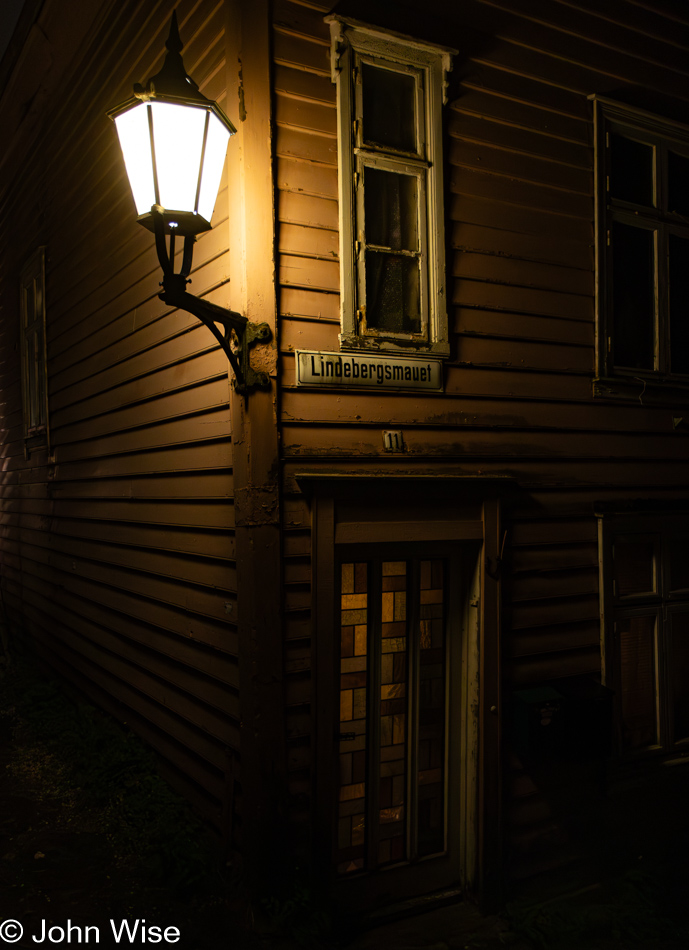
With a right turn on Lindebergsmauet, we are only two minutes away from our hotel and the end of yet another day of delight; it must have been due to the God of Raspberries.